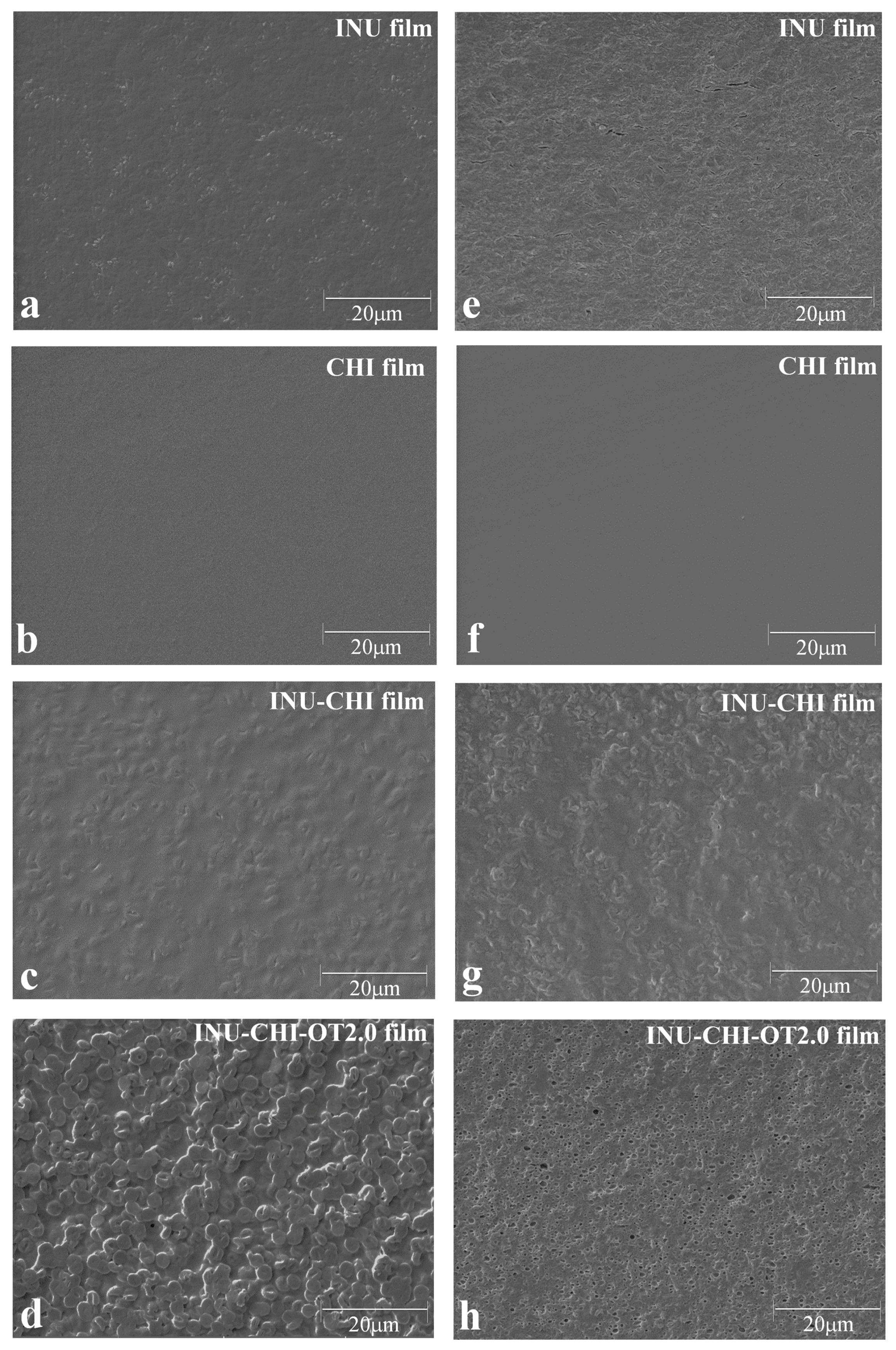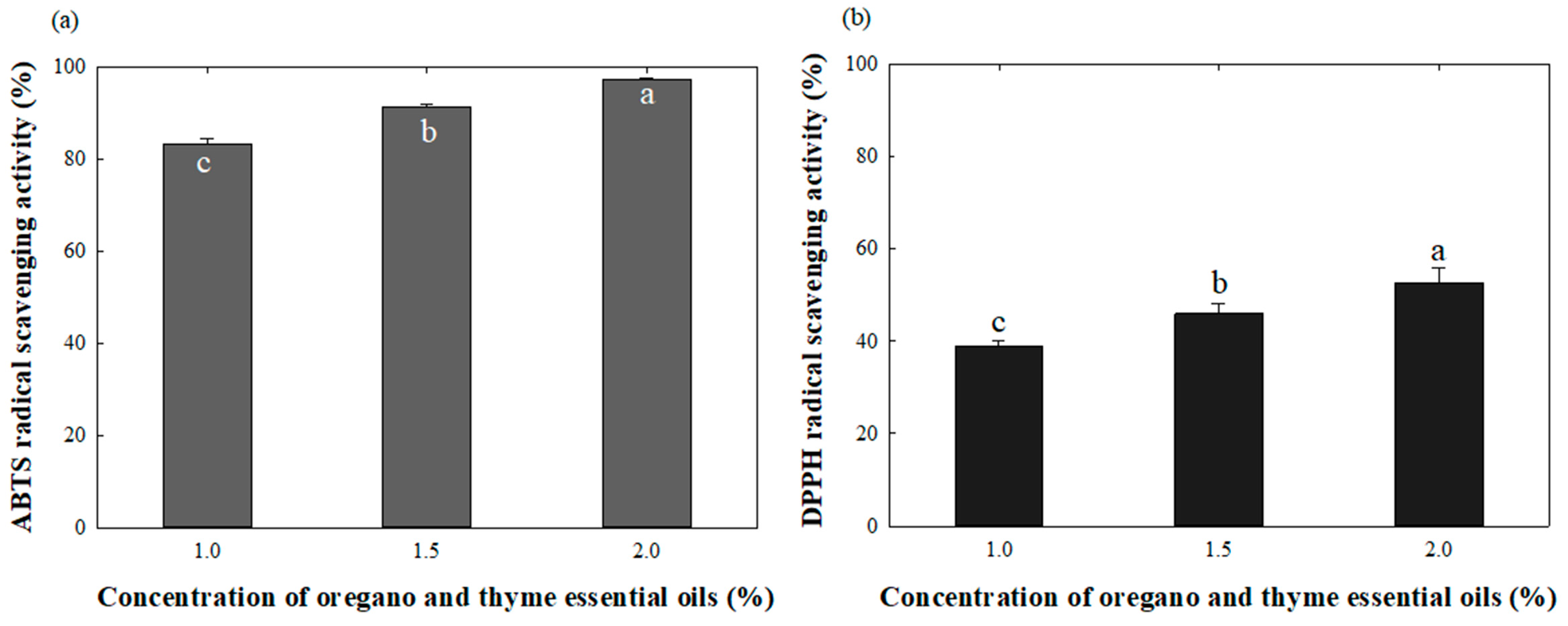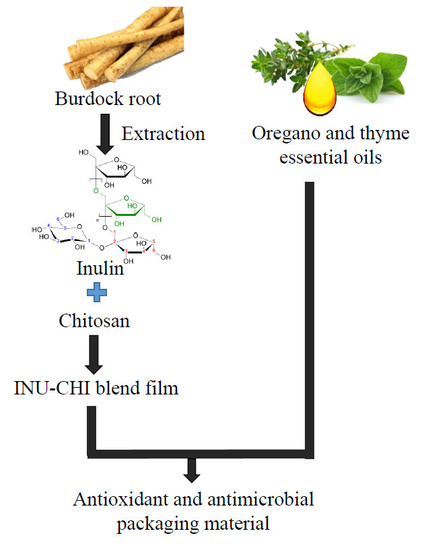Development of Burdock Root Inulin/Chitosan Blend Films Containing Oregano and Thyme Essential Oils
Abstract
:1. Introduction
2. Results and Discussion
2.1. Characterization of Inulin (INU) Extracted from Burdock Root
2.2. Physical Properties of the Films
2.3. Optical Properties
2.4. Attenuated Total Reflectance-Fourier Transformation Infrared (ATR-FTIR) Spectroscopy
2.5. Scanning Electron Microscopy Images of the Inulin (INU), Chitosan (CHI), and INU-CHI Films
2.6. Antioxidant Activities of Films Containing Oregano and Thyme Essential Oils (OT)
2.7. Antimicrobial Activities of Films Containing OT
3. Materials and Methods
3.1. Materials
3.2. Extraction of INU
3.3. Determination of DP of INU Extracted from Burdock Roots
3.4. Film Preparation
3.5. Physical Properties Measurement
3.6. Optical Properties of the Films
3.7. ATR-FTIR Spectroscopy
3.8. Scanning Electron Microscopy
3.9. Antioxidant Activities
3.10. Antimicrobial Activities
3.11. Statistical Analysis
4. Conclusions
Acknowledgments
Author Contributions
Conflicts of Interest
References
- Zhu, Z.; He, J.; Liu, G.; Barba, F.J.; Koubaa, M.; Ding, L.; Bals, O.; Grimi, N.; Vorobiev, E. Recent insights for the green recovery of inulin from plant food materials using non-conventional extraction technologies: A review. Innov. Food Sci. Emerg. Technol. 2016, 33, 1–9. [Google Scholar] [CrossRef]
- Mensink, M.A.; Frijlink, H.W.; van der Voort Maarschalk, K.; Hinrichs, W.L.J. Inulin, a flexible oligosaccharide I: Review of its physicochemical characteristics. Carbohydr. Polym. 2015, 130, 405–419. [Google Scholar] [CrossRef] [PubMed]
- Apolinário, A.C.; de Lima Damasceno, B.P.G.; de Macêdo Beltrão, N.E.; Pessoa, A.; Converti, A.; da Silva, J.A. Inulin-type fructans: A review on different aspects of biochemical and pharmaceutical technology. Carbohydr. Polym. 2014, 101, 368–378. [Google Scholar] [CrossRef] [PubMed]
- Porta, R.; Mariniello, L.; di Pierro, P.; Sorrentino, A.; Giosafatto, C.V.L. Transglutaminase crosslinked pectin- and chitosan-based edible films: A review. Crit. Rev. Food Sci. Nutr. 2011, 51, 223–238. [Google Scholar] [CrossRef] [PubMed]
- Di Pierro, P.; Sorrentino, A.; Mariniello, L.; Giosafatto, C.V.L.; Porta, R. Chitosan/whey protein film as active coating to extend Ricotta cheese shelf-life. LWT Food Sci. Technol. 2011, 44, 2324–2327. [Google Scholar] [CrossRef]
- Elsabee, M.Z.; Abdou, E.S. Chitosan based edible films and coatings: A review. Mater. Sci. Eng. C 2013, 33, 1819–1841. [Google Scholar] [CrossRef] [PubMed]
- Qiao, C.; Ma, X.; Zhang, J.; Yao, J. Molecular interactions in gelatin/chitosan composite films. Food Chem. 2017, 235, 45–50. [Google Scholar] [CrossRef] [PubMed]
- Talón, E.; Trifkovic, K.T.; Vargas, M.; Chiralt, A.; González-Martínez, C. Release of polyphenols from starch-chitosan based films containing thyme extract. Carbohydr. Polym. 2017, 175, 122–130. [Google Scholar] [CrossRef] [PubMed]
- Chandrasekar, V.; Coupland, J.N.; Anantheswaran, R.C. Release kinetics of nisin from chitosan–alginate complex films. J. Food Sci. 2016, 81, 2503–2510. [Google Scholar] [CrossRef] [PubMed]
- Ren, L.; Yan, X.; Zhou, J.; Tong, J.; Su, X. Influence of chitosan concentration on mechanical and barrier properties of corn starch/chitosan films. Int. J. Biol. Macromol. 2017, 105, 1636–1643. [Google Scholar] [CrossRef] [PubMed]
- Lagouri, V.; Guldas, M.; Gurbuz, O. In vitro antioxidant/free radical scavenging and antibacterial properties of endemic oregano and thyme extracts from Greece. Food Sci. Biotechnol. 2011, 20, 1487–1493. [Google Scholar] [CrossRef]
- Leyva-López, N.; Gutiérrez-Grijalva, E.P.; Vazquez-Olivo, G.; Heredia, J.B. Essential oils of oregano: Biological activity beyond their antimicrobial properties. Molecules 2017, 22, 989. [Google Scholar]
- Nikolić, M.; Jovanović, K.K.; Marković, T.; Marković, D.; Gligorijević, N.; Radulović, S.; Soković, M. Chemical composition, antimicrobial, and cytotoxic properties of five Lamiaceae essential oils. Ind. Crops Prod. 2014, 61, 225–232. [Google Scholar]
- Pei, R.S.; Zhou, F.; Ji, B.P.; Xu, J. Evaluation of combined antibacterial effects of eugenol, cinnamaldehyde, thymol, and carvacrol against E. coli with an improved method. J. Food Sci. 2009, 74, 379–383. [Google Scholar] [CrossRef] [PubMed]
- Gavaric, N.; Mozina, S.S.; Kladar, N.; Bozin, B. Chemical profile, antioxidant and antibacterial activity of thyme and oregano essential oils, thymol and carvacrol and their possible synergism. J. Essent. Oil Bear. Plants 2015, 18, 1013–1021. [Google Scholar] [CrossRef]
- Ku, Y.; Jansen, O.; Oles, C.J.; Lazar, E.Z.; Rader, J.I. Precipitation of inulins and oligoglucoses by ethanol and other solvents. Food Chem. 2003, 81, 125–132. [Google Scholar] [CrossRef]
- Bonilla, J.; Atarés, L.; Vargas, M.; Chiralt, A. Effect of essential oils and homogenization conditions on properties of chitosan-based films. Food Hydrocoll. 2012, 26, 9–16. [Google Scholar] [CrossRef]
- Bourtoom, T.; Chinnan, M.S. Preparation and properties of rice starch–chitosan blend biodegradable film. LWT Food Sci. Technol. 2008, 41, 1633–1641. [Google Scholar] [CrossRef]
- Pelissari, F.M.; Grossmann, M.V.E.; Yamashita, F.; Pineda, E.A.G. Antimicrobial, mechanical, and barrier properties of cassava starch−chitosan films incorporated with oregano essential oil. J. Agric. Food Chem. 2009, 57, 7499–7504. [Google Scholar] [CrossRef] [PubMed]
- Luo, D.; Li, Y.; Xu, B.; Ren, G.; Li, P.; Li, X.; Han, X.; Liu, J. Effects of inulin with different degree of polymerization on gelatinization and retrogradation of wheat starch. Food Chem. 2017, 229, 35–43. [Google Scholar] [CrossRef] [PubMed]
- Bangyekan, C.; Aht-Ong, D.; Srikulkit, K. Preparation and properties evaluation of chitosan-coated cassava starch films. Carbohydr. Polym. 2006, 63, 61–71. [Google Scholar] [CrossRef]
- Perdones, Á.; Chiralt, A.; Vargas, M. Properties of film-forming dispersions and films based on chitosan containing basil or thyme essential oil. Food Hydrocoll. 2016, 57, 271–279. [Google Scholar] [CrossRef]
- Yuan, G.; Lv, H.; Yang, B.; Chen, X.; Sun, H. Physical properties, antioxidant and antimicrobial activity of chitosan films containing carvacrol and pomegranate peel extract. Molecules 2015, 20, 11034–11045. [Google Scholar] [CrossRef] [PubMed]
- Garcia, M.A.; Pinotti, A.; Zaritzky, N.E. Physicochemical, water vapor barrier and mechanical properties of corn starch and chitosan composite films. Starch-Stärke 2006, 58, 453–463. [Google Scholar] [CrossRef]
- Tongnuanchan, P.; Benjakul, S.; Prodpran, T. Properties and antioxidant activity of fish skin gelatin film incorporated with citrus essential oils. Food Chem. 2012, 134, 1571–1579. [Google Scholar] [CrossRef] [PubMed]
- Hosseini, S.F.; Rezaei, M.; Zandi, M.; Farahmandghavi, F. Bio-based composite edible films containing Origanum vulgare L. essential oil. Ind. Crops Prod. 2015, 67, 403–413. [Google Scholar] [CrossRef]
- Chan, Y.S.; Cheng, L.N.; Wu, J.H.; Chan, E.; Kwan, Y.W.; Lee, S.M.Y.; Leung, G.P.; Yu, P.H.; Chan, S.W. A review of the pharmacological effects of Arctium lappa (burdock). Inflammopharmacology 2011, 19, 245–254. [Google Scholar] [CrossRef] [PubMed]
- Peng, Y.; Li, Y. Combined effects of two kinds of essential oils on physical, mechanical and structural properties of chitosan films. Food Hydrocoll. 2014, 36, 287–293. [Google Scholar] [CrossRef]
- Pontes, A.G.O.; Silva, K.L.; da Cruz Fonseca, S.G.; Soares, A.A.; de Andrade Feitosa, J.P.; Braz-Filho, R.; Romero, N.R.; Bandeira, M.A.M. Identification and determination of the inulin content in the roots of the Northeast Brazilian species Pombalia calceolaria L. Carbohydr. Polym. 2016, 149, 391–398. [Google Scholar] [CrossRef] [PubMed]
- Xu, J.; Chen, D.; Liu, C.; Wu, X.Z.; Dong, C.X.; Zhou, J. Structural characterization and anti-tumor effects of an inulin-type fructan from Atractylodes chinensis. Int. J. Biol. Macromol. 2016, 82, 765–771. [Google Scholar] [CrossRef] [PubMed]
- Mudannayake, D.C.; Wimalasiri, K.; Silva, K.F.; Ajlouni, S. Comparison of properties of new sources of partially purified inulin to those of commercially pure chicory inulin. J. Food Sci. 2015, 80, 950–960. [Google Scholar] [CrossRef] [PubMed]
- Silva, S.M.; Braga, C.R.; Fook, M.V.; Raposo, C.M.; Carvalho, L.H.; Canedo, E.L. Application of infrared spectroscopy to analysis of chitosan/clay nanocomposites. In Infrared Spectroscopy—Materials Science, Engineering and Technology; InTech: Rijeka, Croatia, 2012. [Google Scholar]
- Hu, C.; Li, G.; Wang, Y.; Li, F.; Guo, G.; Hu, H. The effect of pH on the bonding of Cu2+ and chitosan-montmorillonite composite. Int. J. Biol. Macromol. 2017, 103, 751–757. [Google Scholar] [CrossRef] [PubMed]
- Barclay, T.G.; Rajapaksha, H.; Thilagam, A.; Qian, G.; Ginic-Markovic, M.; Cooper, P.D.; Gerson, A.; Petrovsky, N. Physical characterization and in silico modeling of inulin polymer conformation during vaccine adjuvant particle formation. Carbohydr. Polym. 2016, 143, 108–115. [Google Scholar] [CrossRef] [PubMed]
- Salvatore, E.; Pes, M.; Mazzarello, V.; Pirisi, A. Replacement of fat with long-chain inulin in a fresh cheese made from caprine milk. Int. Dairy J. 2014, 34, 1–5. [Google Scholar] [CrossRef]
- Sedlaříková, J.; Doležalová, M.; Egner, P.; Pavlačková, J.; Krejčí, J.; Ondřej Rudolf, O.; Peer, P. Effect of oregano and marjoram essential oils on the physical and antimicrobial properties of chitosan based systems. Int. J. Polym. Sci. 2017, 2017, 2593863. [Google Scholar] [CrossRef]
- Jouki, M.; Yazdi, F.T.; Mortazavi, S.A.; Koocheki, A. Quince seed mucilage films incorporated with oregano essential oil: Physical, thermal, barrier, antioxidant and antibacterial properties. Food Hydrocoll. 2014, 36, 9–19. [Google Scholar] [CrossRef]
- Mastelic, J.; Jerkovic, I.; Blažević, I.; Poljak-Blaži, M.; Borović, S.; Ivančić-Baće, I.; Smrečki, V.; Žarković, N.; Brčić-Kostic, K.; Vikić-Topić, D.; et al. Comparative study on the antioxidant and biological activities of carvacrol, thymol, and eugenol derivatives. J. Agric. Food Chem. 2008, 56, 3989–3996. [Google Scholar] [CrossRef] [PubMed]
- Kavoosi, G.; Dadfar, S.M.M.; Mohammadi Purfard, A.; Mehrabi, R. Antioxidant and antimicrobial properties of gelatin films incorporated with carvacrol. J. Food Saf. 2013, 33, 423–432. [Google Scholar] [CrossRef]
- Langeveld, W.T.; Veldhuizen, E.J.; Burt, S.A. Synergy between essential oil components and antibiotics: A review. Crit. Rev. Microbiol. 2014, 40, 76–94. [Google Scholar] [CrossRef] [PubMed]
- Hosseini, M.H.; Razavi, S.H.; Mousavi, M.A. Antimicrobial, physical and mechanical properties of chitosan-based films incorporated with thyme, clove and cinnamon essential oils. J. Food Process. Preserv. 2009, 33, 727–743. [Google Scholar] [CrossRef]
- Cao, T.L.; Yang, S.Y.; Song, K.B. Characterization of barnyard millet starch films containing borage seed oil. Coatings 2017, 7, 183. [Google Scholar] [CrossRef]
- Lee, J.H.; Lee, J.; Song, K.B. Development of a chicken feet protein film containing essential oils. Food Hydrocoll. 2015, 46, 208–215. [Google Scholar] [CrossRef]
- Yang, H.J.; Lee, J.H.; Won, M.; Song, K.B. Antioxidant activities of distiller dried grains with solubles as protein films containing tea extracts and their application in the packaging of pork meat. Food Chem. 2016, 196, 174–179. [Google Scholar] [CrossRef] [PubMed]
- Kim, H.; Beak, S.E.; Yang, S.Y.; Song, K.B. Application of an antimicrobial packaging material from chicken bone gelatine and cinnamon bark oil to mozzarella cheese. Int. J. Food Sci. Technol. 2017. [Google Scholar] [CrossRef]




| Samples | Tensile Strength (MPa) | Elongation at Break (%) |
|---|---|---|
| INU | 5.10 ± 0.38 f | 5.11 ± 0.45 d |
| CHI | 41.65 ± 1.76 a | 5.22 ± 0.32 d |
| INU-CHI | 26.58 ± 1.44 b | 19.98 ± 1.26 c |
| INU-CHI-OT 1.0 | 23.33 ± 1.92 c | 23.08 ±1.73 b |
| INU-CHI-OT 1.5 | 20.02 ± 0.98 d | 25.71 ± 1.83 a |
| INU-CHI-OT 2.0 | 17.08 ± 0.76 e | 25.42 ± 2.80 a |
| Essential Oil Concentration (%) | Water Vapor Permeability (10−9 g/m s Pa) | Water Solubility (%) | Moisture Content (%) |
|---|---|---|---|
| INU | 4.23 ± 0.19 a | 62.12 ± 1.40 a | 11.32 ± 0.45 f |
| CHI | 3.48 ± 0.09 c | 22.39 ± 0.62 e | 21.59 ± 0.31 a |
| INU-CHI | 3.74 ± 0.27 b | 35.15 ± 0.46 b | 17.38 ± 0.29 b |
| INU-CHI-OT1.0 | 3.46 ± 0.17 c | 34.94 ± 0.57 b | 15.73 ± 0.29 c |
| INU-CHI-OT1.5 | 3.21 ± 0.15 d | 33.12 ± 0.89 c | 14.08 ± 0.23 d |
| INU-CHI-OT2.0 | 3.15 ± 0.19 d | 32.41 ± 0.93 d | 12.23 ± 0.16 e |
| Samples | Opacity (A/mm) | L | a | b |
|---|---|---|---|---|
| INU | 21.90 ± 0.36 a | 79.34 ± 0.47 f | −0.04 ± 0.01 a | 23.65 ± 0.41 a |
| CHI | 0.38 ± 0.03 f | 96.59 ± 0.16 a | −2.99 ± 0.20 e | 11.49 ± 0.39 e |
| INU-CHI | 3.28 ± 0.05 e | 89.51 ± 0.80 b | −2.08 ± 0.03 d | 18.39 ± 1.25 d |
| INU-CHI-OT1.0 | 3.66 ± 0.04 d | 86.55 ± 0.42 c | −1.95 ± 0.04 c | 20.36 ± 0.80 c |
| INU-CHI-OT1.5 | 4.00 ± 0.06 c | 85.64 ± 0.45 d | −1.94 ± 0.02 c | 20.75 ± 0.54 bc |
| INU-CHI-OT2.0 | 4.70 ± 0.12 b | 84.87 ± 0.36 e | −1.82 ± 0.01 b | 21.02 ± 0.57 b |
| Inhibition Zone (mm) | ||||
|---|---|---|---|---|
| Essential Oil Concentration (%) | L. monocytogenes | S. aureus | E. coli O157:H7 | S. typhimurium |
| INU-CHI | ND * | ND | ND | ND |
| INU-CHI-OT1.0 | 16.50 ± 0.32 c | 17.07± 0.17 c | 12.82 ± 0.29 c | 11.80 ± 0.18 c |
| INU-CHI-OT1.5 | 17.31 ± 0.18 b | 18.14 ± 0.19 b | 16.38 ± 0.23 b | 12.57 ± 0.19 b |
| INU-CHI-OT2.0 | 19.38 ± 0.17 a | 18.95 ± 0.18 a | 18.44 ± 0.28 a | 14.64 ± 0.12 a |
© 2018 by the authors. Licensee MDPI, Basel, Switzerland. This article is an open access article distributed under the terms and conditions of the Creative Commons Attribution (CC BY) license (http://creativecommons.org/licenses/by/4.0/).
Share and Cite
Cao, T.L.; Yang, S.-Y.; Song, K.B. Development of Burdock Root Inulin/Chitosan Blend Films Containing Oregano and Thyme Essential Oils. Int. J. Mol. Sci. 2018, 19, 131. https://doi.org/10.3390/ijms19010131
Cao TL, Yang S-Y, Song KB. Development of Burdock Root Inulin/Chitosan Blend Films Containing Oregano and Thyme Essential Oils. International Journal of Molecular Sciences. 2018; 19(1):131. https://doi.org/10.3390/ijms19010131
Chicago/Turabian StyleCao, Thi Luyen, So-Young Yang, and Kyung Bin Song. 2018. "Development of Burdock Root Inulin/Chitosan Blend Films Containing Oregano and Thyme Essential Oils" International Journal of Molecular Sciences 19, no. 1: 131. https://doi.org/10.3390/ijms19010131





